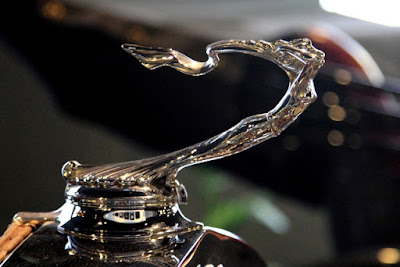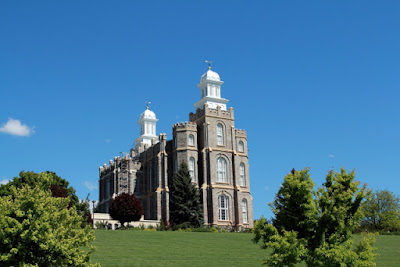When I learned that Ogden Union Station offered four museum tickets for the price of one, how could I resist such an offer!
Historically, "Union Station" was a common name given to train stations that shared the same tracks and facilities by two or more railway companies. In Ogden, the Union Pacific and the Central Pacific Railroads shared facilities.
Several train stations were constructed in Ogden before the current structure was completed in 1924. For some extra publicity, when the station was dedicated a picture of 13 young ladies pulling the first train into the station was widely distributed. One Italian newspaper picked up the picture and printed it their paper with the caption "Curious American Custom."
The center portion of the station ceiling is 56 feet high and murals are painted at both ends of the lobby. Located on the walls under the murals are drinking fountains surrounded by colored mosaics, which were a popular attraction.
In 1977, Amtrak leased the property to the City of Ogden and donated a substantial amount of railroad equipment to the city so that the station could be converted into a community center and a museum. The station now houses the Utah State Railroad Museum, John M. Browning Firearms Museum, Browning-Kimball Classic Car Museum, Western Heritage and Utah Cowboy Museum, The Myra Powell Gallery, a temporary art gallery, research library, restaurant, model train shop, Steam Restoration Shop, and various other areas and retail spaces. Everything in the building is free to the public, except the four main museums, which costs $4 per person (total).
The Utah State Cowboy & Western Heritage Museum is just off of the main lobby and contains a variety of rodeo items, including a video of historic State Rodeo Queens. There is also a temporary art museum located on the opposite side of the lobby.
The John M. Browning Firearms Museum contains a wide variety of firearms and a very informative movie about John Browning and the history of firearms. John Browning was considered to be a genius when it came to designing firearms and he patented the vast majority of firearms built during his lifetime. Since he could not manufacture all of his patents, he sold most of his patents to Winchester, Remington, Colt, and foreign firearms manufactures. You could easily spend all day in just this museum.
The Myra Powell Gallery is just across the hall from the Browning Museum.
One of my favorite museums was the Browning-Kimball Classic Car Museum. With exception of a 1901 Oldsmobile, all of the vehicles were high-end classic cars, so you did not see any Chevrolets or Fords!
I asked my wife which vehicle was her favorite and she pointed to the 1911 Knox. I said that I could see why she picked that vehicle because it was an engineering marvel with its straight-six-overhead-cam engine that had external rockers and push-rods. She said that she did not know what I was talking about, but she liked the car because of the seats and the color! I decided to view the other vehicles by myself.
The Railroad museum has both indoor and outdoor exhibits. One of the more interesting indoor exhibits is a replica of the Golden Spike of 1869 and the original safe where it was stored. Historically, the original gold spike was stored in the safe at the Stanford University Museum, but the building was extensively damaged in the 1989 Loma Prieta earthquake and it required 10 years to rebuild the museum. When the museum reopened in 1999, the Golden Spike of 1869 was housed in a new special display case and the safe was transferred to the Railroad Museum in Ogden.
The locomotives on display are primarily the big, powerful ones that were build to haul heavy loads over the mountains between Wyoming and California.
#833 is one of the fastest and most powerful steam-driven locomotives ever built. The large driver wheels are over six feet in diameters, which helped the locomotive reach speeds of up to 110 miles per hour. The "elephant ears" on the front of the locomotive look strange, but they were designed to lift smoke from the boiler up and over the engineer's cab.
#6916 was built in 1969, 100 years after the transcontinental railroad was completed at Promontory Summit on May 10, 1869; thus, it was called the "Centennial Locomotive." The locomotive is powered by two 3300-horsepower General Motors Electro-Motive Division V-16 diesel engines. Top speed was 91 miles per hour.
#7457 was the first Model SD-45 built for the Southern Pacific Railroad. The locomotive was so well received that eventually Southern Pacific purchased 355 more units. The locomotive is powered by a 3600-horsepower General Motors Electro-Motive Division V-20 diesel engine. Top speed was 65 miles per hour.
#X-26 is the World's most powerful locomotive ever built and is capable of puling 735 fully loaded freight cars. (That's a train 7 miles long.) The locomotive is powered by a turbine engine that is capable of producing 8500-horsepower. X-26 was called a "Big Blow" because it makes a deafening noise like a jet airplane flying by. It is one of only two "Big Blows" on public display. The other one is located at the Illinois Railway Museum in Union, Illinois.
Scattered around the rail yard are a number of other locomotives, rail cars, and equipment used for working on trains.
The Ogden Dinosaur Park and Museum is located at the mouth of Logan Canyon and it is a popular attraction for families. We were unable to stop for a tour of the facility because they did not have an area for trailer parking and I was really fortunate to find a place where I could turn around. (I stopped on the street and took a few pictures while the people behind me were honking their horns and waiving at me.)
We then decided to follow the Logan Canyon National Scenic Byway through Logan Canyon and up to the Uinta-Wasatch-Cache National Forest to Woodruff.
Woodruff is called "Utah's North Pole" because of the high elevation and extreme winters, but as you enter the town a sign says that they have the "Warmest Hearts." The town was named for Wilford Woodruff, who lived in Randolph nineteen miles up the road.
Wilford Woodruff built his log cabin in Randolph in 1872 and lived there until 1876. When he was 82 years old he became President of the LDS Church and lived in Salt Lake City until he died 10 years later. Randolph is also the location of the Smallest Store in Utah and some beautiful fields covered with yellow flowers.
Half of Bear Lake is located in Utah and the other half is located in Idaho -- both parts of the lake are popular tourist destinations. For travelers that want to experience the "real west," they can rent a tent or stay in a covered wagon for the night.
Utah State University is land-grand university located in Logan and home of the Utah State Aggies. Everyone kept telling me that I had to stop by the University and try some home-made Aggie Ice Cream, but when I arrived the building was closed! All I could find was a herd of painted Aggie Cows scattered all over town.
Just down the street from the University is the LDS Logan Temple and Tabernacle.
There was reported to be a picturesque historic grain elevator in Hyrum, but all I could find were some log buildings in front of the Hyrum Municipal complex. There were no information signs on the log structures, so I have no idea what they represent.
Before leaving for Idaho, we stopped in Brigham City to take pictures of the LDS Temple and Tabernacle. We had planned to eat at the world famous Maddox Ranch House Restaurant, but it was closed. Well, maybe some other time!



































































No comments:
Post a Comment